En primeur: Anger and frustration to resignation
Resignation seemed to dominate the mood among merchants and other market commentators as the 2013 campaign was chalked down as yet another “missed opportunity”.
From the seeming anger directed towards châteaux during the 2011 campaign for failing to lower prices and bad release timing, to frustration when it happened again with the 2012s, this year was streaked with resignation.
Anthony Maxwell, co-director at Liv-ex told the drinks business that the campaign was almost in trouble right from the start. Db had asked back in December whether the campaign was heading into a perfect storm.
“Everyone was expecting it to be bad,” said Maxwell. “The wine quality was in doubt, there appeared to be no appetite for price cuts from châteaux, there was a general malaise in the market etc.
“And generally prices failed to change that sentiment.”
He said that the first 200 releases were just 4% down on the average 2012 prices and 30% up on the 2008s.
“They just didn’t come down enough,” explained Maxwell. “There was the opportunity to really get people back in it but it was just not enough.”
A “missed opportunity” was echoed by Joss Fowler of Fine & Rare, Max Lalondrelle of Berry Bros & Rudd, Gary Boom at Bordeaux Index and Will Hargrove of Corney & Barrow, who sounded most disappointed that the chance to re-engage buyers with Bordeaux had gone begging.
Boom said that the failed campaign will, “only add to negative image that is pervading people’s minds at the moment.”
Price was of course the main cause for the lack of interest. There is an understanding among the trade that good wines are expensive to produce and 2013 was difficult which added to the costs.
“There’s a limit to how far they can come down to, it costs money to produce these wines,” Fowler conceded before adding that one shouldn’t forget either, “that they’ve all got gold-plated cellars to pay for.”
It wasn’t all doom and gloom, some wines did sell well, the first growths, Lynch Bages, l’Eglise Clinet and some of the whites being the usual examples – even if volumes and buyer interest were lower than 2012.
“There was absolutely less interest,” said Fowler while Lalondrelle and Boom reported that it had been the worst campaign either had overseen.
Lalondrelle did say that one had to see things in perspective, the 2009 and 2010 campaigns involved wines with large volumes and bigger prices so merchants were able to turnover more impressive results in both volume and value than with the much smaller 2011s, 2012s and 2013s.
Partner Content
Furthermore, with quality an issue, merchants have been more selective, which further drives down the levels of volume and value its possible to reach.
Berry Bros only selected 30-50 wines this year. Lalondrelle said: “We tried to build our campaign with wines that are cheap in relation to previous vintages and are good wines to drink or will be good to drink.
“We have sold, overall, a third of what we did last year. But the ‘11s, ‘12s and ‘13s aren’t brilliant vintages so we sold less of them.”
Hargrove said that even if everything Corney & Barrow had taken on had not gone through yet he was actually quite looking forward to some “old fashioned” selling on the phones with clients.
Overall the speed of the campaign seems to have pleased most the only dissenting voice being Lalondrelle who told the drinks business near the start of the campaign that he did not mind if the campaign was a little long.
Explaining that the window for selling a wine is relatively short before moving onto the next, he said: “There are plenty of wines we could have sold more of if there hadn’t been as much at a time.”
There are still a few big names to release; Pichon Lalande, Yquem, Le Pin and Ducru Beaucaillou the key names, they’ll probably release next week but they’ll have to do something spectacular if they’re to cause any excitement.
Even if Yquem was rated the best wine of the vintage, it’s price adjustment since 2005 has made it extremely bad at maintaining its release price on the secondary market.
There’s little expectation that Robert Parker’s scores when they come out in August will yield any great surprises though if he gives solid scores to certain wines that the merchants quite like then it offers another chance to push them a little.
“Parker will give the Bordeaux, UK and world trade the chance to promote the wines just once more,” thought Lalondrelle. “Even if we sell only another 100 cases on the back of it.”





The apparent demise of Bdx en Primeur is unfortunate but producers only have themselves to blame as loyal customers were priced out of the market in 2009/10 because of ridiculous prices hikes as the chateaux were interested only in chasing more lucrative emerging markets. Those of more limited means who overstretched in the peak years have seen considerable losses in value in some instances as many wines from these vintages are now trading substantially below their original offer price.
For the producers to reduce the offer price in a year that many are describing as mediocre, while the anticipated interest from emerging markets has failed to materialise, will not encourage their original customer base back into the Primeurs market.
The only way that producers can hope to re-engage with their original customer base is to offer incentive of price reductions in a ‘good’ vintage. It is not rocket science. But then, given the way things have gone in recent years, one must assume that institutional purchasers and those with the biggest wallets would wade in and purchase the lot.